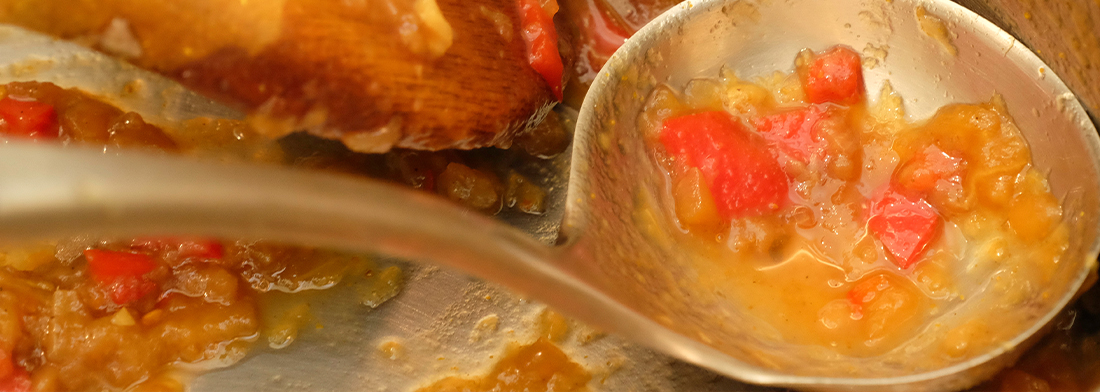Eggplant, Ginger & Chilli Chutney
- Pickles, Chutney, Relish & Sauces
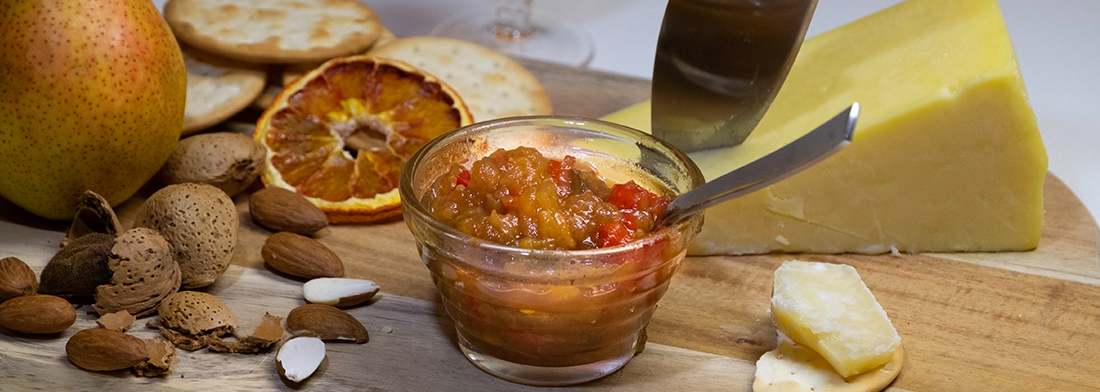
A Mediterranean inspired chutney full of sun-drenched eggplants, red capsicums and garlic spiced up with fresh ginger and a good curry powder. Very versatile and with the twist of the lid it adds a new dimension to an antipasto platter, ploughman’s plank or a bitey cheddar cheese, alongside a curry or with grilled and cold meats. I’ve even had it with my Sunday morning bacon and eggs and home-made sourdough bread. A truly delicious combination.
We now grow extra eggplants and capsicums to make multiple batches. By the time its shared with family and friends I need to make sure there’s always enough stashed away in the pantry for our use. An easy chutney to make that uses up excess eggplant and capsicums.
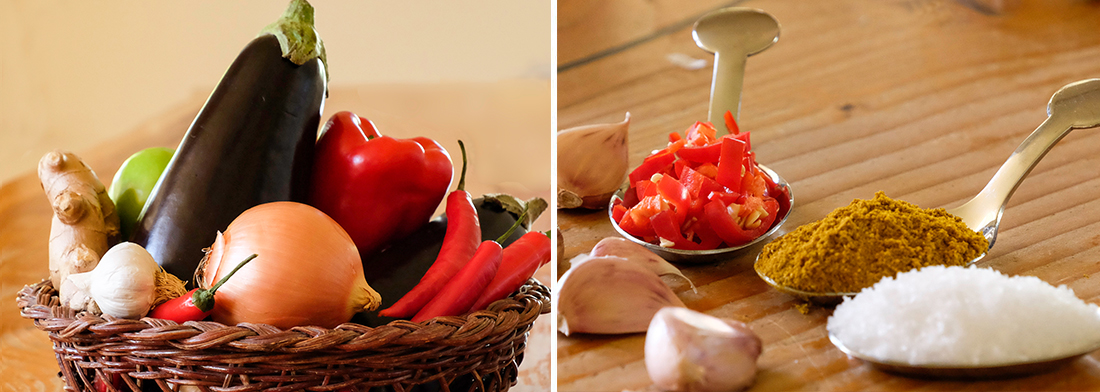
- Preparation Time:
- 50 minutes
- Cooking Time:
- 60 minutes
- Quantity:
- 7 x 300 ml jars
PREPARATION
Sterilise and dry sealable glass jars and lids.
Pre-wash eggplant, capsicum and chilli.
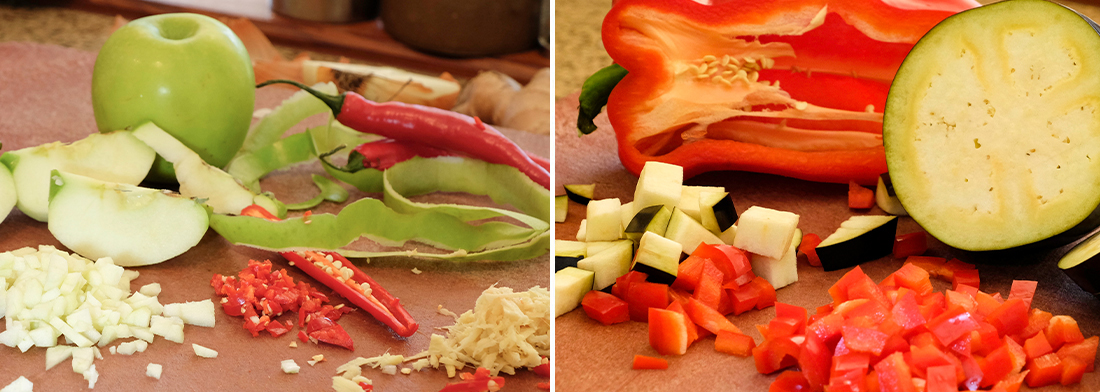
INGREDIENTS
- 2 medium
- Purple eggplants, chopped into 1 cm (1/3 inch) square
- 2 medium
- Red capsicums
- 2 large
- Granny Smith (green cooking) apples
- 250g
- Brown onion, peeled and finely chopped
- 4
- Fresh garlic cloves
- 5 cm (2 inches)
- Fresh ginger root, peeled and finely chopped
- 2 medium
- Red chillies - hot
- 1.5 tablespoons
- Curry powder
- 375g
- White sugar (or light brown sugar if this is your preference)
- 600ml
- Apple cider vinegar
- 600ml
- Water
- 1 teaspoon
- Salt
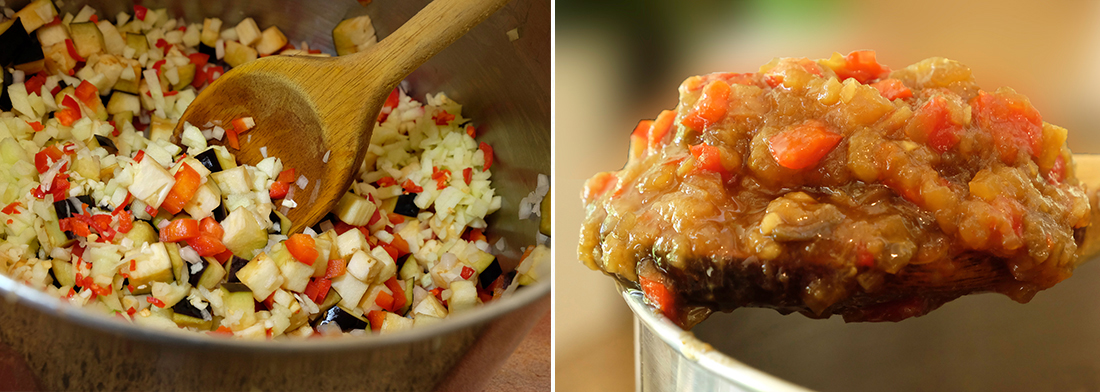
METHOD
Peel and finely chop the garlic. Remove stalk end from the chilli and discard. Finely chop the remaining chilli. Remove the inner white membrane and de-seed if you what a mild chilli flavour.
Cut the red capsicums in half, remove the white membrane and de-seed and chop into 1 cm (1/3 inch ) square pieces. Peel the apple, remove the core and chop the same size as the eggplant and red capsicum.
Place the chopped capsicum, apple, onion and eggplant in a large preserving pan with the chopped garlic, chilli, and ginger, vinegar and water. Bring to the boil then turn down to a gentle simmer and cook until soft. Stir occasionally to prevent the chutney from sticking to the bottom of the pan.
Mix the curry powder with a tablespoon of cold water to make a paste. Add the paste, sugar, and salt. Simmer uncovered, stirring occasionally to prevent it from catching and burning on the bottom of the pan, until it has a thick consistency. Remove from the heat and allow to cool slightly.
Using a funnel and ladle pour the chutney into warm dry sterilised screw cap sealable jars. Fill to approximately 2.5cm (1/4 inch) from the top of the bottle and seal.
-
Label and store in a cool dark place in the kitchen or pantry.
Allow the chutney mature for at least 2 weeks before eating.
NOTES
- Choose clean ripe fruit. Do not use overripe and never use mouldy fruit or vegetables as this will produce a poor-quality chutney.
- For a chunky chutney texture, cut the vegetables into larger pieces.
- Stir occasionally to prevent the chutney from sticking on the bottom of the pan. But not too often so the fruit doesn’t break down into a mush.
- The cooking time is an approximation only. Cooking time will depend upon;
- the size of preserving pan- the broader the pan the quicker the evaporation,
- degree of ripeness – the riper the fruit and vegetables the sweet and juicer the initial chutney will be and the
- degree of heat when cooking – the higher the heat, the greater the boil which will produce greater evaporation.
- It is important to wash your hands thoroughly after handling and de-seeding chillies. Chilli oil is easily transferred from the chillies to hands. If you touch your eyes or any delicate areas, the chilli oil will be transferred on contact and create a burning sensation.
- The type and colour of the sugar and vinegar used will affect the final colour and flavour of the chutney. Malt vinegar and brown sugar will produce very dark brownish red chutney with a more earthy/molasses background flavour, while white wine vinegar or apple cider and white sugar will produce chutney that has a fresher and brighter tomato flavour. This is a matter of personal choice.
- To test the chutney is cooked to the right consistency, spoon a little of the mixture on to a plate. The chutney should hold its shape.
- Towards the end of the cooking process, it may be necessary to stir regularly. It is important that the fruit does not stick to the bottom of the pan and burn. Your chutney will be tainted with a burnt flavour and it is not very pleasant.
Variations
For a fruitier chutney add 185 gm seeded chopped raisins with the sugar and cook as the recipe.
For a spicier chutney add additional curry powder, chilli and ginger to your taste. 